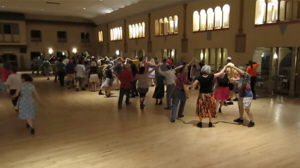 American for All
American for All
Different people enjoy different aspects of American Dance. Colin will try to cater for all tastes: some energetic, some tricky, some traditional.

Wendy Crouch, who started the Southam Festival, didn't like American at all, though she was sensible enough to realise that other people did, and always booked good American-style callers. Wendy said American was boring. I suppose another objection might be that it's too energetic, though Wendy was happy with traditional English so she wouldn't have thought that. And some people don't like American-style music, and feel that the Playford-style tunes make the dances so much more satisfying. I'd like to know who at this workshop is not very keen on American, and please try and explain why. I promise I won't pick on you for the rest of the weekend, but I might just be able to change your point of view.
As with many things in life, you get out of dancing what you put into it. Let me demonstrate the way some couples do a balance and swing followed by lines forward and back.
![]() [Setting right and left twice while looking at the floor, a walked swing once around and then stand there with hands out waiting for the band to catch up.]
[Setting right and left twice while looking at the floor, a walked swing once around and then stand there with hands out waiting for the band to catch up.]
I accept that if you're unwell or infirm you might need to dance this way, but I don't believe most people are — they just don't want to put any effort into it. Maybe people think a swing is too energetic — but it doesn't have to be. Although contra dancers in America say the swing is the most important part of the dance, they often use part of the time for twirling rather than actually swinging. Let me demonstrate. And then you try it.
And you can do a walked swing rather than a pivot (buzz) step, provided you put a bit of life into it. You can even do this while the other person is doing a pivot step. What you can't do is rotate at different speeds — there needs to be some adjustment. Men — if you've got any awareness of body language you can sense when the lady doesn't want to do a fast swing — don't force her to move faster than she wants.
Christmas Hornpipe
Also known as Vinton's Hornpipe. See the instructions here. This comes from the Ralph Page book of contras — you can borrow this from archive.org/details/Contrablend
See the instructions here. By contrast, here's a dance by Cary Ravitz, who specialises in tricky contras. On his website he gives rules for writing contras — such as you need a partner swing and a neighbour swing — but within these constraints he manages to weave some fascinating patterns which keep you on your toes — especially when you're near the end of the set. This one is a change partner dance too.Most modern contras flow very smoothly — you never have to turn back on yourself and you're almost always connected to people. It's about giving weight and working as a team — just as Playford is. The roll away into the circle right is fine so long as the men lead their partner from one move into the next — don't stop dancing at any point or you're dead! In fact it's a feature of modern contras that you never stop moving — which some people like and some hate. I'll admit there are times when I'm very glad to have four bars rest while the ladies do a do-si-do or a right-hand turn. I like the flow of this dance; I like the fact that several times you're turning away from one person to do the next move with someone else. Of course it means you have to think ahead — some people don't like that! You can't do a figure, stop, reassess the situation and then decide what to do next. And you have to stay awake at the end of the set — just keep doing the dance and you'll be fine.
Pop the Line
Now let's look at Squares. Many contra dancers in the States don't like Squares, because they have to think too hard (though they wouldn't put it like that). Again I want to bring out the variety, so we'll start with one which is traditional in style and has many variations. The figure is done by two couples at a time, either Heads or Sides — the others just stand there and watch. Contra dancers don't like standing and watching — that's why you don't get the ones leading down the centre and back in modern contras; it's always leading down in a line of four. In my view you're still part of the dance whether you're moving or not, and you take an interest in what the active couples are doing. You could even learn by their mistakes!Of course there's a break at the beginning, middle and end where everyone's moving. I love it when the caller varies the break every time to keep you guessing, but some people clearly don't, so I'll do the same simple break all three times: allemande left, grand chain, promenade, swing.
